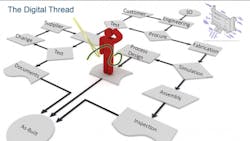Demystifying the Digital Thread and Digital Twin Concepts
The concepts of the digital thread and digital twin have been spearheaded by the military aircraft industry in their desire to improve the performance of future programs. They apply lessons learned through these digital technologies to current and upcoming programs.
However, these concepts and technologies are gaining interest beyond the aerospace and defense industry and are converging with the digital manufacturing and cyber-physical system goals of Industrie 4.0 and Smart Manufacturing.
In the Industrie 4.0 roadmap, a cyber-physical system refers to the digital representation of a physical system used to communicate properties and live status to other cyber-physical systems and applications in future smart factories. Smart Manufacturing strives to orchestrate and optimize business, digital and physical processes across smart factories and the entire product value chain. As system architects evaluate these initiatives, it makes sense that these similar digital connectivity goals start converging into a single framework strategy for manufacturing systems.
The digital twin refers to a digital model of a particular asset that includes design specifications and engineering models describing its geometry, materials, components and behavior. More important, it also includes the as-built and operational data unique to the specific physical asset that it represents. For example, for an aircraft, the digital twin would be identified to the physical product unit identifier which is referred to as the tail number. The data in the digital twin of an aircraft includes things like specific geometry extracted from aircraft 3D models, aerodynamic models, engineering changes cut in during the production cycle, material properties, inspection, operation and maintenance data, aerodynamic models, and any deviations from the original design specifications approved due to issues and work-arounds on the specific product unit.
The digital thread refers to the communication framework that allows a connected data flow and integrated view of the asset’s data throughout its lifecycle across traditionally siloed functional perspectives. The digital thread concept raises the bar for delivering “the right information to the right place at the right time.”
Expected Benefits of a Digital Twin
The benefits expected from having a digital twin for each product unit include:
- More effective assessment of a system’s current and future capabilities during its lifecycle
- Early discovery of system performance deficiencies by simulating results way before physical processes and product are developed
- Optimization of operability, manufacturability, inspectability, and sustainability leveraging models and simulations applied during the entire lifecycle of each tail number
- Continuous refinement of designs and models through data captured and easily crossed referenced to design details
The digital thread should provide a formal framework for controlled interplay of authoritative technical and as-built data with the ability to access, integrate, transform, and analyze data from disparate systems throughout the product lifecycle into actionable information. The product lifecycle includes: Design, Procurement, Test & Evaluation, Production, Field Operation, and Sustainment Services.
Together, the digital thread and digital twin include as-designed requirements, validation and calibration records, as-built data, as-flown data, and as-maintained data.
Current and Future Scenarios
The current approach to the handover between departments follows the "throw it over the wall" approach, including the following:
- Product engineering creates a 3D model and throws it over the wall to Manufacturing Engineering
- Manufacturing Engineering creates 2D drawings from 3D models and throws it over the wall to Quality and Suppliers
- Quality creates conformance requirements and throws them over the wall to Production
- Production throws the product unit over the wall to the customer and into the sustainment cycle without any data on the specific unit beyond the original design
- Production archives as-built to records for auditing purposes
The future scenario, using the digital thread and digital twin, would look something like the following:
- Product Engineers working together with Manufacturing Engineers create a 3D model linked to visuals for production process instructions
- Product characteristics are linked to 3D models and extracted directly out of designs into conformance requirements
- Conformance requirements are linked to manufacturing process and inspection instructions
- As-built data is delivered by Production along with product unit to customer and is made available for sustainment services to continue evolving the unit’s data during operation and maintenance services
- Product design changes follow the same data flow and automatically update downstream models, references and instructions.
Getting Beyond the Digital Challenges
Interesting Use Cases
Today, we must take the experts to the physical product unit to help troubleshoot issues where they are found. Tomorrow, with a digital twin, we could have experts in different locations looking at the same digital representation of the actual product unit. The Material Review Board (MRB) processes for nonconformance and deviations could be improved by involving more experts remotely and leveraging simulations to figure out the impact to the overall product performance before rework deviations are approved.
During sustainment services, maintenance technicians can receive direct support with the latest and most accurate information on the state and condition of the equipment. Data from smart connected equipment would be aggregated, analyzed and transformed into actionable information for the maintenance staff. Technicians can focus on trouble-shooting the issues at hand rather than performing lengthy diagnostics processes at every service visit.
Potential Challenges
Can people responsible for upstream lifecycle functions understand and accommodate the needs of people in downstream functions for the overall better outcome to the entire program? Will feedback mechanisms be put in place to ensure we continue to improve the upstream processes that serve the downstream processes?
We have already seen concepts like design-for-manufacturing well adopted by industry. The concepts of the digital twin can be viewed as evolutionary and a natural progression on that type of thinking beyond the manufacturing process.
Can vendors see beyond their desire to hold a segment of the market hostage to their formats and products? Could they endorse open data exchange standards were needed to facilitate multi-vendor participation in the digital thread?
Can manufacturers, hardware, and software vendors move forward when many are overwhelmed trying to meet short-term improvement goals promised to customers and shareholders?
The digital thread and digital twin concepts have been proposed as incremental steps and leading companies are moving forward with these initiatives. Only time will tell but the potential benefits of the digital thread and digital twin seem obvious. The vendors that endorse and provide these types of connectivity techniques could end up being favored by the market in the long term over vendors with proprietary closed solutions.
References
Global Horizons Final Report: United States Air Force Global Science and Technology Vision - AF/ST TR 13-01, United States Air Force, 2013
About the Author

Conrad Leiva
VP Product Strategy and Alliances
Based in the Los Angeles area, Conrad Leiva is vice president of ecosystem and workforce development at CESMII – the Smart Manufacturing Institute. He is accelerating Smart Manufacturing adoption through partners and education programs. A recognized industry authority, he engages business leaders, educators and practitioners to share the How and Why of leveraging information technology in manufacturing. Conrad has over 30 years of experience in aerospace manufacturing and 10 years working on Smart Manufacturing practices with industry leaders at MESA International.

